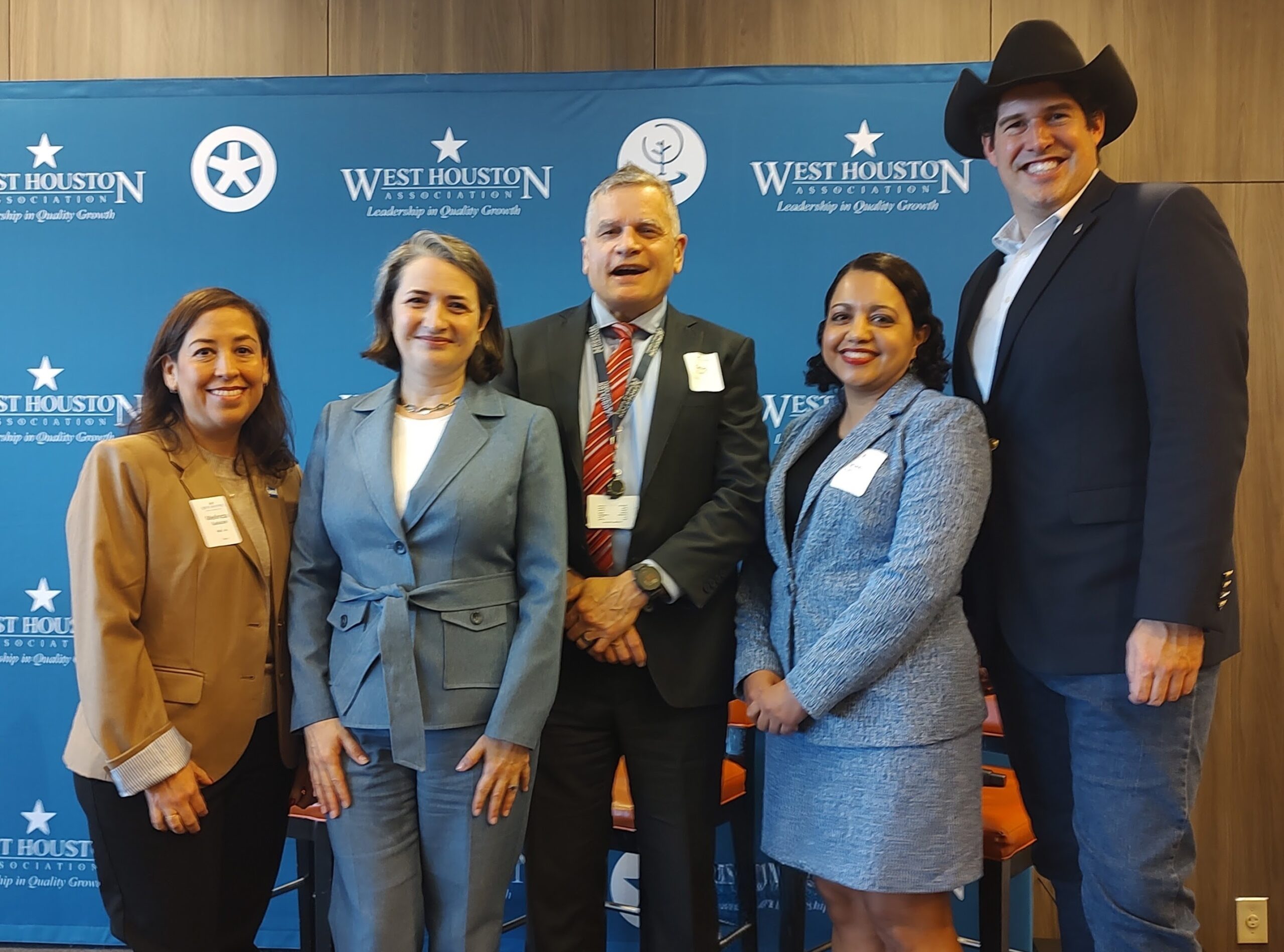On Thursday, February 6th, a panel of experts gathered to discuss the widespread and urgent nature of Houston’s aging water infrastructure, a problem that extends far beyond the city’s borders. The forum, moderated by Melinda Salazar, Chair of WHA’s Water Resource Committee, featured Greg Eyerly (City of Houston), Kate Hallaway (BGE), and Alia Vinson (ABHR), each offering a unique perspective on the critical state of the city’s water systems.
Salazar opened the discussion by inviting the panelists to introduce themselves and provide background on their roles within the water sector. As each panelist shared their experiences, it became clear that the challenges facing the water industry are complex and urgent. Laying the foundation for the conversation, Greg Eyerly wasted no time, bluntly stating, ‘You can’t solve a problem until you admit that you have one.'” Alia Vinson reinforced that the challenges extend beyond the city, noting that “The City of Houston serves more people outside of their corporate limits than inside,” explaining that the city’s water infrastructure serves approximately 5.5 million people residing in Harris and Fort Bend Counties. For example, 84% of the capacity of the Northeast Water Plant expansion is paid for and owned by regional water authorities, with only 16% funded by the city itself. As Vinson emphasized, “This is a regional issue, not just a city issue.”

In response to a question about the current state of Houston’s water system, Eyerly recounted a story in which, while walking with Mayor Whitmire near a waterway, he pointed to a nearby rail car and remarked, “All it would take to shut the city down is for a rail car like that to get into our raw water supply.” A few days later, that very scenario nearly occurred. Fortunately, the city was able to remove the rail car without contaminating the water, but the incident highlighted a critical weakness in Houston’s water infrastructure being lack of redundancy in its raw water sources. Unlike Dallas, which has multiple sources of water to ensure resilience, Houston faces significant risks if its primary sources fail.
Kate Hallaway shared strategies for managing the city’s aging and fragile infrastructure. She outlined two approaches to infrastructure management: “Run to failure” and preventative planning. The “run to failure” approach, while cheaper in the short term because it avoids upfront costs, is ultimately far more expensive due to the destructive costs of dealing with failures when they occur. Comparatively, preventative plans (Capital Improvement Plans, or CIP) involve investing in maintenance before issues arise, reducing long-term disruptions and unexpected costs. Hallaway urged the audience to adopt the latter strategy to protect the city’s future.
Eyerly built on Hallaway’s point, highlighting the risks associated with rushing emergency fixes when failures do occur. He explained that emergency processes often involve shortcuts, leaving room for potential misuse and fraud. “When you rush out to fix things and contracts aren’t properly vetted,” Eyerly warned, “there are opportunities for criminal behavior.” This, he argued, further reinforces the importance of cautious planning and preparedness.
The panelists also highlighted the need for regional cooperation and government support in addressing the water crisis. Eyerly stressed that, “We’re all in this together,” underlining the importance of federal and state assistance to repair and upgrade Houston’s water infrastructure. The governance of regional water authorities, he noted, must involve input from all areas affected by the city’s water systems, not just Houston itself.

Salazar emphasized Eyerly’s thoughts, asking the panelists what components should be prioritized for improvement. Eyerly noted that without continued assistance, Houston faces a grim future in terms of its water supply. “We need federal and state assistance, and we’re going to need repair assistance. The governance of a regional water authority needs regional input. This is all our problem.” Hallaway added that ignoring the issue will only make it worse, and time is of the essence.
In terms of funding, Vinson offered some optimism. She highlighted positive legislative developments, including the creation of the Texas Water Fund, which allocated $1 billion to water projects in the state. A quarter of this fund is dedicated to new water supply projects like desalination, with the remaining portion available for distribution by the Texas Water Development Board (TWDB) into existing water funds. Currently, ongoing discussions aim to secure an additional $5 billion for the fund, with a focus on creating a dedicated revenue source for water infrastructure, like the approach used for TxDOT funded transportation projects. This approach, Vinson argued, would provide a steady flow of funds for water projects, ensuring long-term sustainability.
Vinson also emphasized that in order for urban and suburban areas like Houston to benefit from these funding initiatives, the region must show its commitment by maintaining and reserving local funds. “State and federal funding will not come without seeing that we have ‘skin in the game,’” she explained. Local governments must ensure that tax and utility rates are set with the necessary funding needed to support long-term infrastructure projects.

Eyerly ended on a hopeful note, reminding the audience that Houston is well positioned in terms of its raw water resources, with extensive potential for water reuse. However, he warned that this opportunity will only be fully realized if the city takes the necessary steps to invest in and upgrade its infrastructure.
As the discussion concluded, the panelists shared their final thoughts. Hallaway emphasized that while the challenges are significant, they are not impossible. Vinson urged the audience to consider the rapid growth of the region, noting that 1,500 people move to Houston every day. “If we want to sustain this continued growth,” she said, “we’re going to have to invest in and maintain our infrastructure.”
The panelists left the audience with a clear message: the future of Houston’s water system relies on investment, regional cooperation, and the willingness to face the issues head-on before they reach a breaking point. The time to act is now.
